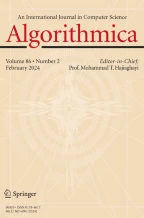Abstract
A star graph is a tree of diameter at most two. A star forest is a graph that consists of node-disjoint star graphs. In the spanning star forest problem, given an unweighted graph G, the objective is to find a star forest that contains all vertices of G and has the maximum number of edges. This problem is the complement of the dominating set problem in the following sense: On a graph with n vertices, the size of the maximum spanning star forest is equal to n minus the size of the minimum dominating set.
We present a 0.71-approximation algorithm for this problem, improving upon the approximation factor of 0.6 of Nguyen et al. (SIAM J. Comput. 38:946–962, 2008). We also present a 0.64-approximation algorithm for the problem on node-weighted graphs. Finally, we present improved hardness of approximation results for the weighted (both edge-weighted and node-weighted) versions of the problem.
Our algorithms use a non-linear rounding scheme, which might be of independent interest.
Similar content being viewed by others
Notes
In fact the value of t depends on the value of the optimal solution of the LP relaxation. Our rounding approach tries to extract as much information as possible from the LP relaxation, in particular, from the optimal LP solution. Usually, the value of an LP solution is used as an upper/lower bound to analyze the performance of the algorithm. We, in addition, use it as a parameter of randomized rounding as well.
For the problem of maximum k-densest subgraph, a randomized rounding using c=0.5 appears to be a folklore result that is attributed to Goemans [7].
References
Agra, A., Cardoso, D., Cerdeira, O., Rocha, E.: A spanning star forest model for the diversity problem in automobile industry. In: ECCO XVIII, Minsk, May 2005
Alon, N., Spencer, J.: The Probabilistic Method. Wiley, New York (1992)
Athanassopoulos, S., Caragiannis, I., Kaklamanis, C., Kyropoulou, M.: An improved approximation bound for spanning star forest and color saving. In: Mathematical Foundations of Computer Science, pp. 90–101 (2009)
Berry, V., Guillemot, S., Nicolas, F., Paul, C.: On the approximation of computing evolutionary trees. In: International Computing and Combinatorics Conference, pp. 115–123 (2005)
Chakrabarty, D., Goel, G.: On the approximability of budgeted allocations and improved lower bounds for submodular welfare maximization and gap. SIAM J. Comput. 39(6), 2189–2211 (2010)
Fiege, U.: A threshold of lnn for approximating set cover. J. ACM 45(4), 634–652 (1998)
Goemans, M.: Mathematical programming and approximation algorithms. Lecture at Udine School, Udine, Italy (1996)
Goemans, M., Williamson, D.: New 3/4-approximation algorithms for the maximum satisfiability problem. SIAM J. Discrete Math. 7(4), 656–666 (1994)
Håstad, J.: Clique is hard to approximate within n 1−ϵ. Acta Math. 182, 105–142 (1999)
Håstad, J.: Some optimal inapproximability results. J. ACM 48(4), 798–859 (2001)
Krauthgamer, R., Mehta, A., Rudra, A.: Pricing commodities. Theor. Comput. Sci. 412(7), 602–613 (2011)
Lund, C., Yannakakis, M.: On the hardness of approximating minimization problems. J. ACM 41(5), 960–981 (1994)
Slavík, P.: A tight analysis of the greedy algorithm for set cover. In: ACM Symposium on Theory of Computing, pp. 435–441 (1996)
Srinivasan, A.: New approaches to covering and packing problems. In: ACM-SIAM Symposium on Discrete Algorithms, pp. 567–576 (2001)
Srinivasan, A.: Personal communication, August 2009
Thach Nguyen, C., Shen, J., Hou, M., Sheng, L., Miller, W., Zhang, L.: Approximating the spanning star forest problem and its application to genomic sequence alignment. SIAM J. Comput. 38(3), 946–962 (2008)
Zuckerman, D.: Linear degree extractors and the inapproximability of max clique and chromatic number. Theory Comput. 3(1), 103–128 (2007)
Acknowledgement
We thank Aravind Srinivasan for clarifying the status of the approximability of the weighted set cover problem.
Author information
Authors and Affiliations
Corresponding author
Additional information
A preliminary version of the paper appeared in the Proceedings of the 10th Intl. Workshop on Approximation Algorithms for Combinatorial Optimization Problems (APPROX 2007).
This work was done when N. Chen, R. Engelberg, P. Raghavendra and G. Singh were visiting the University of Washington.
This work was done when A. Rudra was at the University of Washington and partially supported by NSF CCF-0343672.
Rights and permissions
About this article
Cite this article
Chen, N., Engelberg, R., Thach Nguyen, C. et al. Improved Approximation Algorithms for the Spanning Star Forest Problem. Algorithmica 65, 498–516 (2013). https://doi.org/10.1007/s00453-011-9607-1
Received:
Accepted:
Published:
Issue Date:
DOI: https://doi.org/10.1007/s00453-011-9607-1
